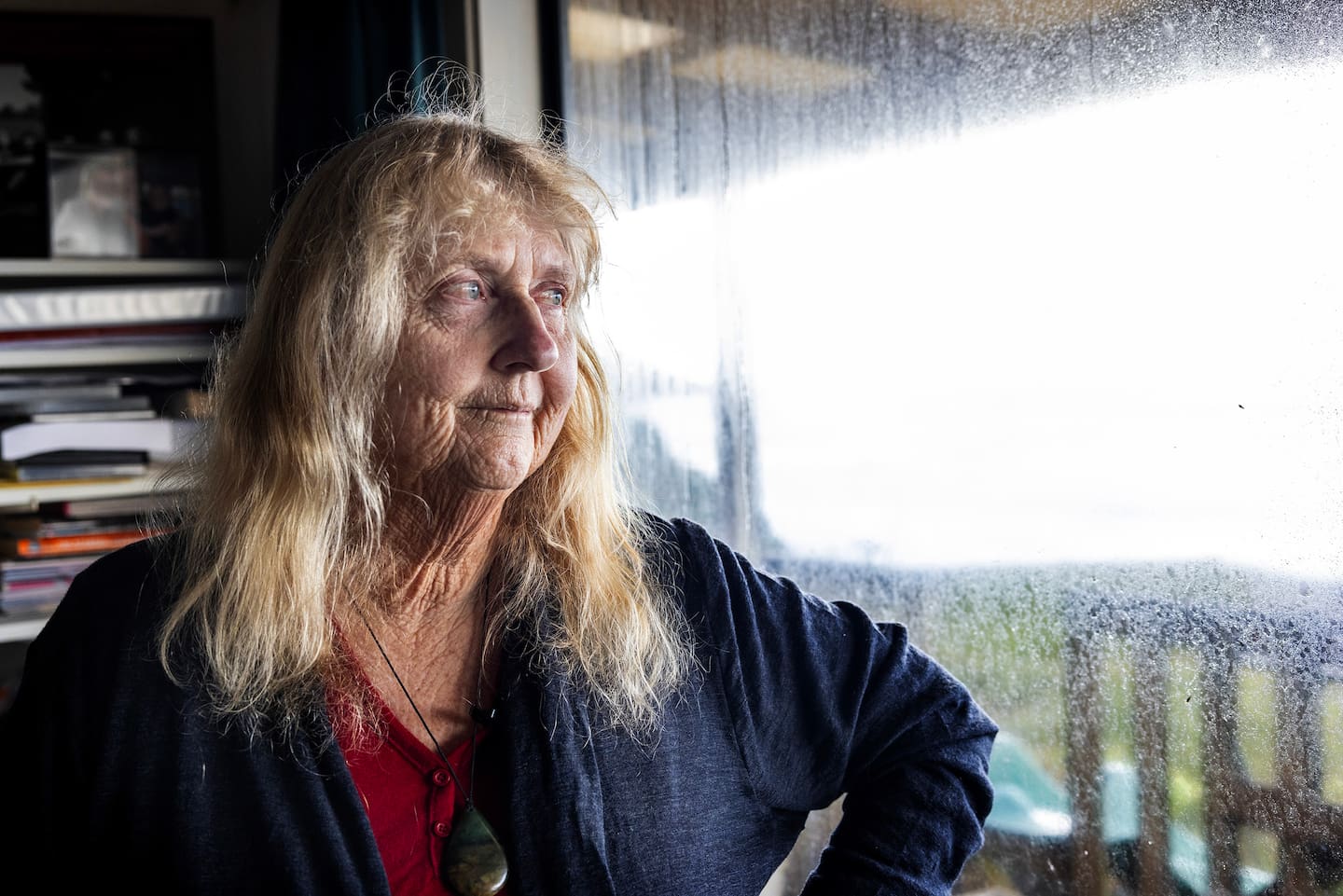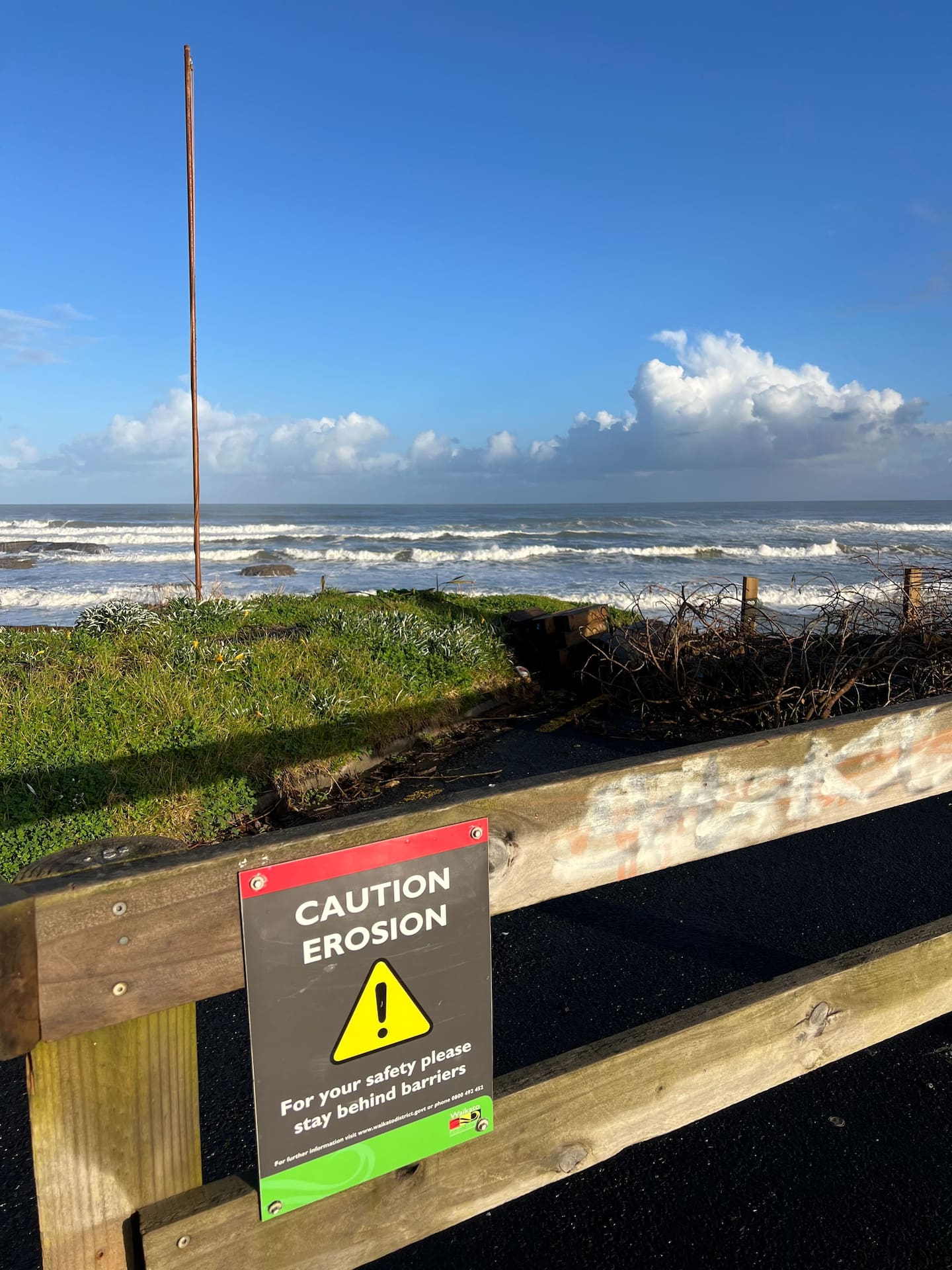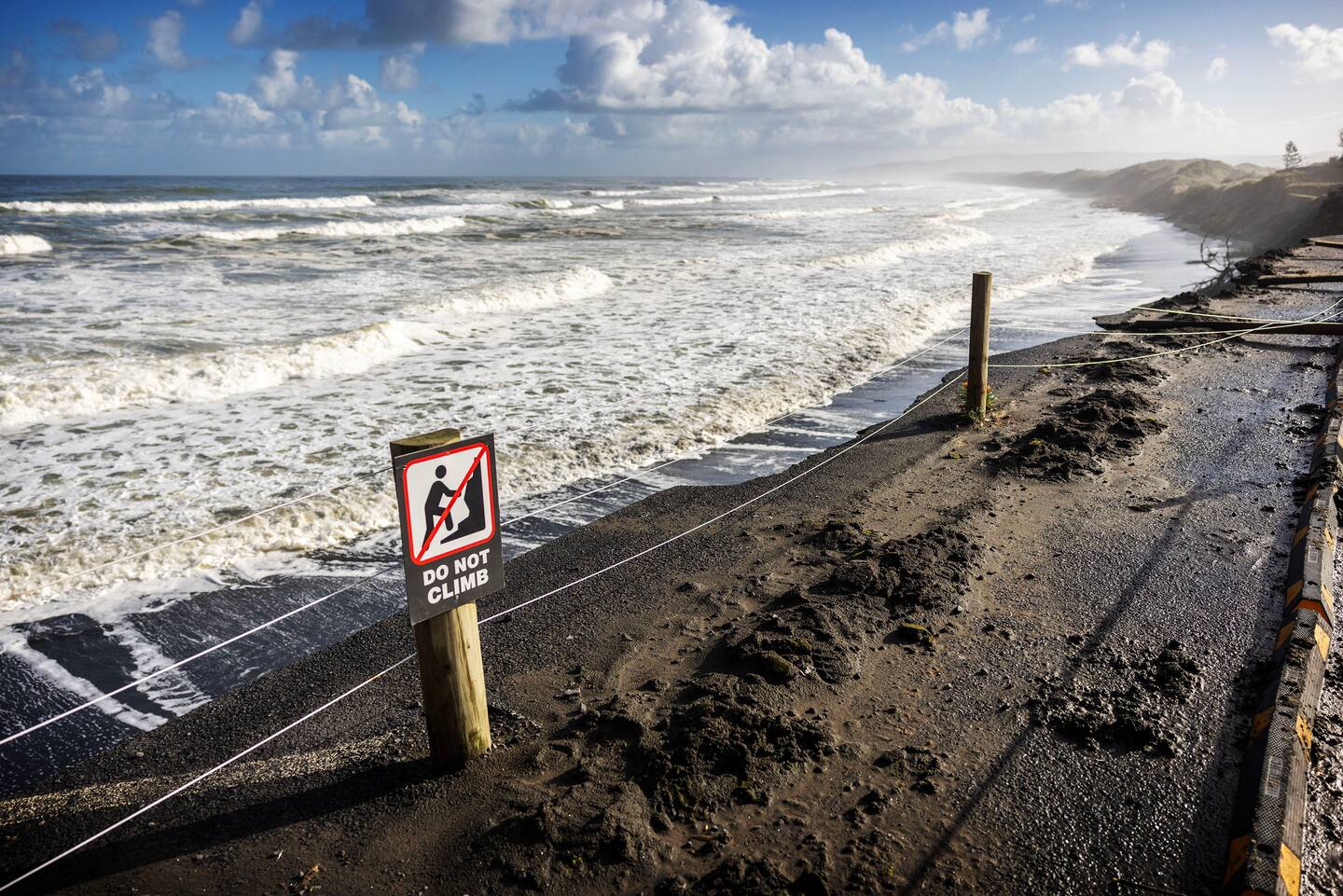Port Waikato residents say they feel “powerless” in the face of coastal erosion that is moving ever closer to their homes.
Years of erosion have caused the coastline to move steadily inland, taking chunks out of sections and putting homes at risk. Some houses have already been left uninhabitable after storms claimed a further three metres of beach in 2022, wiping away the only access.
Now, residents say they don’t know how long they have left in their homes and want more support from the Waikato District Council. The council says there is no viable option to prevent further erosion.
The council closed Port Waikato’s Sunset Beach carpark this week, on July 23 after two metres of the bank supporting it fell into the ocean, making the area unsafe for vehicles and people.
Josephine Poland has lived in her coastal Port Waikato home since 1994, and told the Waikato Herald she feels defeated.
“Some people are scared but I think with me, I just get frustrated that I’m standing still and can’t do anything about it. I don’t like the sense of powerlessness it gives me ... in fact I think it sucks.
 Resident of Sunset Beach in Port Waikato, Josephine Poland, said she doesn't know how long she has left in her home. Photo / Mike Scott
Resident of Sunset Beach in Port Waikato, Josephine Poland, said she doesn't know how long she has left in her home. Photo / Mike Scott
“I’m going to miss being able to see the sea ... it’s hard. I think I get into a mode of ‘What am I going to do’, and it takes my mind off it, but I feel sad too. I’m losing my home, I brought up one and a half families here.
“If I’m lucky, I’ll have till next winter [here] but with the warnings we’re getting ... it could very well be within the next few months, so it’s very uncertain.
“With this last lot [of coastline lost], it’s not what we’ve come to expect. We expected we might lose one metre now and then, but five metres over two weeks is a hell of a lot. It might stop again and I might be here for another three years, or I might not.”
With the financial implications of losing her home and the uncertainty, Poland said she was also dealing with a lot of stress.
“Our local mayor called us ‘climate change refugees’ ... we’re basically having to leave our homes with nothing, so it’s not that different ... Everything is deteriorating, and it’s not worth putting money into because of the uncertainty.”
Poland does unpaid work for a non-profit organisation and says the pension is not enough to live on, let alone rebuild a house or dismantle the one she is in.
“I can’t afford to service my car on a pension ... and I’m mortgage-free. I’m not finishing my kitchen I started fixing after the January 2023 floods ... it put a hole in my roof and destroyed my kitchen.”
 The house with the slide is Josephine Poland's. She has lived there for 30 years. Photo / Mike Scott
The house with the slide is Josephine Poland's. She has lived there for 30 years. Photo / Mike Scott
She was “in limbo” while she tried to work out the next steps.
Erosion was considered a natural event and therefore not covered by the Earthquake Commission (EQC). House and contents insurance also does not cover losses from erosion.
“I b**ch about [it] quite often, that they don’t regard this as a natural disaster.
“If down the road we got a flood, we would get help from ECQ, and it might not be much but it would be something. It would pay for demolishing fences and rehousing ourselves, but we seem to get nothing [regarding erosion damage].
“I’m cooking on a gas stove because I don’t know how long I’m going to be here ... I’ve always thought I could move back into the garage which has a sleepout in it. But now ... it might be that [the erosion] keeps on coming.
“It may not be worth the money spent on shifting to a different building further back on the property, which I think even the council has expected us to do.”
Poland wants more council support and feels stuck between “a rock and a hard place”.
Sunset Beach Surf Lifesaving Club president Malcolm Beattie has also called on the council for help, and he was particularly concerned that carpark access was closed with no sign it would ever reopen.
 Sunset Beach Surf Lifesaving Club president Malcolm Beattie says the council should have "just let Mother Nature be". Photo / Mike Scott
Sunset Beach Surf Lifesaving Club president Malcolm Beattie says the council should have "just let Mother Nature be". Photo / Mike Scott
Beattie believed the issues with the carpark started 25 years ago when it was tar-sealed.
“They should’ve let Mother Nature just be, as it was sand ... we would never have these problems. They built a fabricated wall which caused a lot of the issues but the primary thing is the storm water.”
Beattie said storm water drainage had been fixed around the roads before, but pointed out the water running away beneath his feet was going straight down the crumbling banks.
“The wall formed a cliff face and for the energy just banging against it, it consequently just undermines it ... beaches like Piha and Muriwai have had these issues, they’re what we call ‘slugs of sand’ that come up from down south and head north ... it can take many years but they come and fill in.
“We haven’t had any more sand come in here and that’s the issue. No sand and just continuous big-energy surf like we’re getting.”
He said he’s been in conversation with the council many times, and was “getting nowhere” with the storm water.
 A timelapse of erosion at Port Waikato from 2013-23.
A timelapse of erosion at Port Waikato from 2013-23.
“Councils around the country ... they’re hiding behind that plan that came through in the previous Government under the ‘Adaptive Management Plan’ or ‘Manage Retreat’. That enabled councils to say ‘Sorry, manage retreat’, but what does this mean?” Beattie said.
“So does that mean goodbye, does it? Let all these houses wash away? I want them to wipe retreat completely out of their language.
“Retreat means abandonment, retreat means letting the community drown, and I’m not up for that.”
Beattie said the community needs more council support.
“Identify where the issues are with storm water and fix it, spend money ... they won’t spend money on little communities like this but they’ll spend money in places like Hamilton because we don’t have enough ratepayers to fund it ... they just say no funds.
“Closing the carpark is one thing but what is their plan? You get into small coastal communities like this, it’s mostly retirees and a lot of elderly people, they feel quite vulnerable so the panic starts. Already ... you’re hearing ‘Better try to sell our homes.’”
“It’s like the movie Apocalypse Now ... The apocalypse is happening now ... we can’t sit back anymore.
“They have got to make emergency funds available and emergency funds here now because I would suggest we might not be sitting here in a year’s time.”
 Coastal erosion has forced the closure of the Sunset Beach carpark, the accessway to the local community hub. Photo / Mike Scott
Coastal erosion has forced the closure of the Sunset Beach carpark, the accessway to the local community hub. Photo / Mike Scott
Council response
Waikato District Council’s Deputy Mayor Carolyn Eyre said she feels for the community.
“If I had a magic wand to wave, I’d be casting it over the Port because I feel for them ... I feel the pain. I know it’s an emotive topic to be discussing, having to move away from your home and your livelihood ... I get that.”
She said there were previous plans to mitigate risks to the community, which included building a sea wall, when hard defence mechanisms were considered years ago.
“We ruled that out because of several reasons, first and foremost is the cost of it and we didn’t have any evidence that would necessarily support it was going to be effective as a long-term feasible option.”
When asked if there are future plans for a bank to stop seawater from coming in, Eyre said it wasn’t a viable option.
“We know it’s an issue at the moment with high tides coming in and king tides coming ... But we’re aware of it and monitoring it, and working with the community to put in place some short-term measures.”
 Waikato District Council's Deputy Mayor Carolyn Eyre said she feels for the Port Waikato community. Photo / Mike Scott
Waikato District Council's Deputy Mayor Carolyn Eyre said she feels for the Port Waikato community. Photo / Mike Scott
Eyre emphasised that “managed retreat” was not a “do nothing policy”.
Over the years the council has worked on initiatives like sand renourishment trials.
“We had some success with that so our staff went one step further and made a consent on behalf of the community to allow for numerous consents and push-ups throughout the year,” Eyre said.
“That consent is held by the community ... they can access that whenever they desire. So no, it’s not do nothing, but we recognise it’s a dynamic coastline, and unfortunately, erosion is not going to be halted.”
She said nature is taking its toll but they’re looking at feasible options to slow erosion down while continuing community conversations about adaptation and long-term safety.
Eyre said the council recognises demolition was a significant and painful cost to landowners, but there are some things councils can’t do.
“Unfortunately, we aren’t permitted to use ratepayer money to support private property. However, what we can do and ... are doing is working with the community to put our staff on the ground to collect any of the debris fallen off those dunes, from the properties, that’s on the beach,” she said.
“We’re taking additional steps to keep the community safe, that’s why we ... [closed] the carpark because first and foremost, the community safety is at heart as well in our decision-making.”
 Warning signs at Port Waikato's Sunset Beach. Photo / Malisha Kumar
Warning signs at Port Waikato's Sunset Beach. Photo / Malisha Kumar
She said the council is working on ways to support the community, including an upcoming drop-in session at the community hub. She also said they are aware of a community-led group proposal to address the immediate risk.
“That’s something we will have to unpack and give consideration to - whether it’s viable options, we do really want to support the community,” Eyre said.
The council has set up a team to support the community and affected landowners directly, and help explore options for removal or relocation.
“We are monitoring and working with Waikato Regional Council to understand what that’s going to mean for our community. The concern is when the dunes may be breached by the water and we want to have some systems in place for that community protection.”
Eyre said the challenges were not unique to Port Waikato.
The council has looked at what other councils are doing but each approach was particular to its community.
“At the Raglan wharf not so long ago, we had to move the top public facilities and toilet facilities from the beach there due to erosion.
“We have just created a governance group with Waikato Regional Council in terms of our district-wide resilience. That’s going to kick off as a community-led type partnership ... also with Port Waikato and Raglan, and communities of our district to support them.”
Regarding the storm water issue, Eyre said they had done studies to understand the problem.
“We’ve actually been successful not so long ago with some central government funding and storm water management and building resilience in the community that we’re looking at projects the community have identified as first priority.
“But in the interim for this event, we’ve said that 500 sandbags will go out to the carpark to just ensure that the storm water runoff isn’t exacerbating the erosion issue.”
 Warning signs at Sunset Beach, Port Waikato. Photo / Mike Scott
Warning signs at Sunset Beach, Port Waikato. Photo / Mike Scott
Cause of erosion at Port Waikato
Waikato Regional Council’s team leader for regional resilience Rick Liefting said coastal erosion is a natural process “of natural beach behaviour”.
He said the primary driver of erosion at Port Waikato was reduced sand supply due to wave processes.
“When viewed over a long period such as 100 years, the shoreline in Waikato is simply shifting backwards and forwards. However, we cannot predict if and when the erosion cycle changes.”
Liefting said historical records show the current shoreline is in a very similar position to the Sunset Beach carpark in 1942.
“Unfortunately, much of the coastal development in the Waikato region has occurred too close to the sea, resulting in coastal erosion risk [for the communities].
“Development up to the edge of the beach means there’s often nowhere for the dune to retreat to, leading to it simply being lost.”
He said while the recent tides hadn’t been particularly large at Port Waikato, the lower beach and sand volumes were allowing waves to reach the dunes more frequently, causing the shoreline to move landward.
This meant the lower beach levels would be further susceptible to erosion.
Liefting said tide levels are predicted to reduce over the next week, but the forecast wave height may still cause continuous erosion.
“We also know that we will see higher predicted king tides occurring during August, September and October.”
Local government calls on central government
Deputy Mayor Eyre emphasises that coastal erosion is a national issue needing the support of central government.
“We know we can’t come up with the solutions alone. We need some framework and essentially some funding to actually support these communities. Not just in the immediate, but actually in the long-term to be building resilience.”
Eyre said the council was in regular contact with local MP Andrew Bayly, but emphasised the need for partnership with central government.
For the affected community of Sunset Beach, Eyre said, ”We just need to build on those relationships.
“We need to keep talking to each other and we need to find out how we can support within the constraints that we have and, to support the community and work together for what will be, we hope, the best outcome for Port Waikato.”
 Coastal erosion at Sunset Beach is endangering homes and putting the community at risk. Photo / Mike Scott
Coastal erosion at Sunset Beach is endangering homes and putting the community at risk. Photo / Mike Scott
Malisha Kumar is a multimedia journalist based in Hamilton. She joined the Waikato Herald in 2023 after working for Radio 1XX in Whakatāne.
Take your Radio, Podcasts and Music with you









